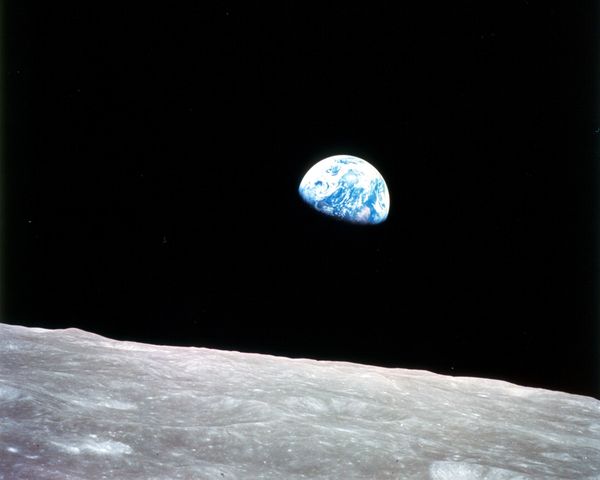NASA has published an amazing photo of the Earth rising over the Moon.
NASA has published a new photograph taken by the Lunar Orbital Probe (LRO) - an automatic interplanetary station, an artificial satellite of the Moon. The photograph shows the surface of the moon, over which the earth rises . Perspectives coincided with the famous “Blue Marble” photo taken 43 years ago by astronaut Harrison Schmitt during the Apollo 17 mission.

In the photo we see the Earth appearing above the horizon of the Moon. The large lighted area is the Sahara Desert. On the moon we see Compton's crater, a large impact crater in the northern hemisphere of the far side of the moon. The full version of the image is available on the lunar orbital probe site, the TIF file weighs 302 megabytes.
The lunar orbital probe launched June 18, 2009, it collects data using seven instruments. Every day he experiences twelve Earth-rising, but his cameras are usually directed to the surface of the satellite. Sometimes he looks toward space to calibrate instruments, and at these moments, the Earth or other planets may fall into his field of vision.
')
To make such a photo is a difficult task. It was assembled from several frames taken on October 12, 2015, when the probe is located at an altitude of 134 kilometers above the Compton crater. The probe travels at a speed of over 1.6 kilometers per second. A narrow-angle camera takes black and white shots in high resolution, while a wide-angle one takes color shots. The final images simultaneously contain photos from these two cameras.
For the first time, Earth’s rise over the moon was filmed on December 24, 1968, while the Apollo 8 spacecraft was flying around the moon. In 1972, astronaut Harrison Schmitt, during the Apollo 17 mission, took a photo that became known as the “Blue Marble”.
Seeing the rise of the Earth, being on the surface of the moon is difficult - the moon is always turned by one side towards our planet. But there is a libration, thanks to which the Earth in the lunar sky describes the likeness of Lissajous figures. Accordingly, there are areas of the moon — edges are relative to the observer; these are about 20% of the surface — on which the sunrises and sunsets of the Earth occur at a frequency of about 30.5 Earth days.

The first photo of the Earth rising over the Moon, 1968

Harrison Schmitt's Blue Marble, 1972, Apollo 17 Mission

In the photo we see the Earth appearing above the horizon of the Moon. The large lighted area is the Sahara Desert. On the moon we see Compton's crater, a large impact crater in the northern hemisphere of the far side of the moon. The full version of the image is available on the lunar orbital probe site, the TIF file weighs 302 megabytes.
The lunar orbital probe launched June 18, 2009, it collects data using seven instruments. Every day he experiences twelve Earth-rising, but his cameras are usually directed to the surface of the satellite. Sometimes he looks toward space to calibrate instruments, and at these moments, the Earth or other planets may fall into his field of vision.
')
To make such a photo is a difficult task. It was assembled from several frames taken on October 12, 2015, when the probe is located at an altitude of 134 kilometers above the Compton crater. The probe travels at a speed of over 1.6 kilometers per second. A narrow-angle camera takes black and white shots in high resolution, while a wide-angle one takes color shots. The final images simultaneously contain photos from these two cameras.
For the first time, Earth’s rise over the moon was filmed on December 24, 1968, while the Apollo 8 spacecraft was flying around the moon. In 1972, astronaut Harrison Schmitt, during the Apollo 17 mission, took a photo that became known as the “Blue Marble”.
Seeing the rise of the Earth, being on the surface of the moon is difficult - the moon is always turned by one side towards our planet. But there is a libration, thanks to which the Earth in the lunar sky describes the likeness of Lissajous figures. Accordingly, there are areas of the moon — edges are relative to the observer; these are about 20% of the surface — on which the sunrises and sunsets of the Earth occur at a frequency of about 30.5 Earth days.

The first photo of the Earth rising over the Moon, 1968

Harrison Schmitt's Blue Marble, 1972, Apollo 17 Mission
Source: https://habr.com/ru/post/367387/
All Articles